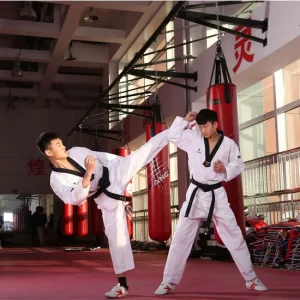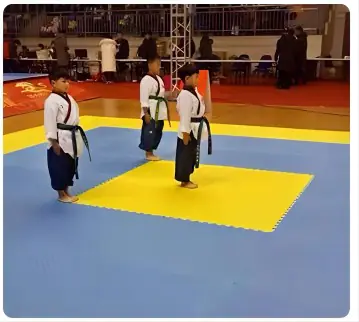A taekwondo journey is both exciting and rewarding. Whether you’re part of a taekwondo club, a martial arts school, or managing a gym, understanding the intricacies of this dynamic martial art can significantly enhance your training and performance. This comprehensive guide delves into the essentials of taekwondo, from its rich history to modern training techniques, providing valuable insights for practitioners and enthusiasts alike.
What is Taekwondo?
Taekwondo is a Korean martial art known for its emphasis on high, fast kicks and jumping and spinning kicks. Combining elements of karate and traditional Korean fighting styles, taekwondo focuses on both physical and mental discipline. Practitioners learn a variety of fighting techniques, including punches, blocks, and kicks, making it a comprehensive form of unarmed combat.
Key Features of Taekwondo
- High Kicks: Signature high and spinning kicks enhance flexibility and agility.
- Forms (Poomsae): Structured patterns of movements that develop balance and technique.
- Sparring (Gyeorugi): Controlled combat practice to apply techniques in real scenarios.
- Self-Defense: Practical applications for personal safety.
Understanding these core aspects is essential for anyone looking to excel in taekwondo, whether you’re training for competition or personal development.
The History of Taekwondo
The history of taekwondo is a rich tapestry woven from various Korean martial arts traditions and modern influences. Originating in the mid-20th century, taekwondo was developed as a unifying martial art that incorporated the best elements of existing Korean fighting styles.
Origins and Development
- 1940s-1950s: Post-Korean War era saw the amalgamation of different martial arts schools (kwans) under a single banner.
- 1960: The formation of the International Taekwon-Do Federation (ITF) by General Choi Hong Hi, who is often regarded as the father of taekwondo.
- 1970s: Expansion of taekwondo internationally, establishing schools and organizations worldwide.
- 2000: Taekwondo made its official debut as an Olympic sport at the Sydney Games, solidifying its global presence.
Influence of Traditional Martial Arts
Taekwondo draws inspiration from ancient Korean martial arts like taekkyeon and subak, blending them with modern techniques to create a versatile and effective combat system.
Different Styles of Taekwondo
While taekwondo maintains a unified set of principles, various styles have emerged, each with its unique focus and training methodologies.
ITF vs. WTF (World Taekwondo Federation)
- ITF (International Taekwon-Do Federation): Emphasizes traditional techniques, forms (tuls), and a structured belt system.
- WTF (World Taekwondo Federation): Focuses on sport-oriented practices, including competitive sparring and point-based scoring systems.
Other Variations
- ATA (American Taekwondo Association): Integrates self-defense techniques and a comprehensive curriculum.
- GTF (Global Taekwondo Federation): Known for its emphasis on athleticism and modern training methods.
Each style offers distinct advantages, catering to different training goals, whether it’s traditional mastery or competitive excellence.
Essential Taekwondo Techniques
Mastering taekwondo requires dedication to learning and perfecting various techniques that form the backbone of this martial art.
Basic Kicks
- Front Kick (Ap Chagi): A fundamental kick targeting the midsection.
- Roundhouse Kick (Dollyo Chagi): A versatile kick used in both offense and defense.
- Side Kick (Yop Chagi): Effective for pushing opponents away or striking from the side.
Advanced Techniques
- Spinning Hook Kick (Dwi Huryeo Chagi): Adds power and unpredictability to your attacks.
- Jumping Back Kick (Twimyo Dwi Chagi): Combines aerial movement with striking force.
- Axe Kick (Naeryo Chagi): A downward strike that targets the head or shoulder area.
Blocks and Punches
- Low Block (Arae Makgi): Protects against low-level attacks.
- High Block (Eolgul Makgi): Shields against high strikes.
- Straight Punch (Jireugi): A direct punch for delivering quick strikes.
Consistent practice of these techniques enhances both physical prowess and mental focus.

Training Equipment for Taekwondo
Having the right training equipment is crucial for effective practice and injury prevention in taekwondo.
Uniform (Dobok)
The taekwondo uniform, or dobok, consists of a jacket, pants, and a belt. It symbolizes the practitioner’s dedication and adherence to the art’s traditions.
Protective Gear

- Headgear: Protects against strikes during sparring.
- Mouthguard: Shields teeth and reduces the risk of concussions.
- Chest Protector: Essential for male practitioners to prevent torso injuries.
- Shin Guards: Safeguard the legs from kicks and impacts.
Sparring Equipment
- Punching Pads: Enhance striking accuracy and power.
- Kicking Shields: Allow safe practice of high and spinning kicks.
- Focus Mitts: Improve hand-eye coordination and speed.
Additional Gear
- Belts (Obi): Indicate rank and progression.
- Training Bags: Provide resistance for strength and endurance training.
- Resistance Bands: Aid in flexibility and strength development.
Investing in quality equipment not only ensures safety but also contributes to a more effective and enjoyable training experience.
Taekwondo in the Olympics
Since its inclusion in the 2000 Sydney Olympics, taekwondo has grown exponentially as a recognized Olympic sport. This global platform has elevated the sport’s status and attracted athletes from diverse backgrounds.
Olympic Taekwondo Categories
- Poomsae (Forms): Demonstrates technique and precision.
- Gyeorugi (Sparring): Competitive matches scored based on strikes and technique effectiveness.
Impact on the Sport
- Increased Visibility: Olympic inclusion has brought taekwondo to a wider audience.
- Standardized Rules: Established guidelines ensure fair competition.
- Enhanced Training Programs: Athletes train rigorously to compete at the highest level.
Notable Olympic Athletes
- Steven López (USA): Multiple-time Olympic medalist known for his exceptional skill and sportsmanship.
- Hadi Saei (Iran): Renowned for his powerful kicks and strategic prowess.
The Olympic stage has not only highlighted individual talents but also inspired countless practitioners to pursue excellence in taekwondo.
Benefits of Practicing Taekwondo
Engaging in taekwondo offers a myriad of physical, mental, and social benefits, making it a holistic form of martial art.
Physical Benefits
- Improved Flexibility: Regular kicking and stretching enhance joint mobility.
- Increased Strength: Builds muscle tone and overall physical power.
- Enhanced Coordination: Develops balance and precise movements.
Mental Benefits
- Discipline: Fosters self-control and focus.
- Confidence: Achieving higher belt ranks boosts self-esteem.
- Stress Relief: Physical activity helps in reducing stress and anxiety.
Social Benefits
- Community Building: Being part of a taekwondo club creates a sense of belonging.
- Respect and Etiquette: Teaches respect for instructors and peers.
- Goal Setting: Encourages setting and achieving personal goals.
Incorporating taekwondo into your routine can lead to significant improvements in overall well-being and personal development.
Choosing the Right Taekwondo School
Selecting the appropriate taekwondo school is pivotal for a fulfilling and effective training experience. Here are key factors to consider:
Instructor Qualifications
Ensure that the instructors are certified by reputable organizations like the World Taekwondo Federation (WTF) or the International Taekwon-Do Federation (ITF). Experienced instructors can provide valuable guidance and mentorship.
Training Programs
Look for schools that offer comprehensive training programs catering to various skill levels, from beginners to advanced practitioners. Programs should include taekwondo training in forms, sparring, and self-defense techniques.
Facilities and Equipment
A well-equipped training facility with adequate space and quality taekwondo equipment enhances the training experience. Check for clean, safe, and organized environments.
Class Size and Atmosphere
Smaller class sizes allow for more personalized attention, while a positive and respectful atmosphere fosters a conducive learning environment.
Reviews and Reputation
Research feedback from current and former students to gauge the school’s reputation and effectiveness in teaching taekwondo.
Trial Classes
Participating in trial classes can provide firsthand experience of the training style and school environment, helping you make an informed decision.
Choosing the right school ensures that your taekwondo journey is both enjoyable and successful.
Taekwondo Competitions: Rules and Scoring
Participating in taekwondo competitions can significantly enhance your skills and provide valuable experience. Understanding the competition rules and scoring system is essential for success.
Competition Formats
- Poomsae (Forms): Judges evaluate the precision, technique, and presentation of the forms performed.
- Gyeorugi (Sparring): Matches are scored based on the effectiveness and accuracy of strikes.
Scoring System
- Points for Valid Kicks and Punches: Points are awarded for delivering accurate and controlled strikes to the scoring areas.
- Penalty Points: Deductions for infractions like stepping out of bounds or excessive force.
- Winning Criteria: The competitor with the highest score at the end of the match wins.
Rules and Regulations
- Protective Gear: Mandatory use of headgear, chest protectors, shin guards, and mouthguards.
- Match Duration: Varies based on the competition level, typically consisting of multiple rounds.
- Fair Play: Emphasis on sportsmanship and respect towards opponents and judges.
Preparation for Competitions
- Physical Conditioning: Enhance strength, endurance, and flexibility.
- Technical Training: Focus on perfecting techniques and strategies.
- Mental Readiness: Develop focus and resilience to perform under pressure.
Participating in competitions not only tests your skills but also fosters personal growth and camaraderie within the taekwondo community.
Frequently Asked Questions
ITF taekwondo emphasizes traditional techniques, forms (tuls), and a structured belt system, while WTF taekwondo focuses on sport-oriented practices, including competitive sparring and point-based scoring systems.
Regularly wash your dobok after training sessions to remove sweat and bacteria. Hang it to dry to prevent wrinkles and extend its lifespan. Avoid using harsh detergents and follow the manufacturer’s care instructions.
Essential protective gear includes headgear, mouthguard, chest protector, shin guards, and sometimes arm guards. This equipment minimizes the risk of injuries during sparring sessions.
The time to achieve a black belt varies depending on the school’s curriculum and the practitioner’s dedication. On average, it can take anywhere from 3 to 5 years of consistent training.
Yes, taekwondo enhances flexibility, strength, endurance, and cardiovascular health. It also contributes to mental well-being by fostering discipline and reducing stress.
Key Takeaways
- Understand Taekwondo: A Korean martial art emphasizing high kicks and disciplined training.
- Rich History: Developed post-Korean War, combining traditional and modern techniques.
- Various Styles: ITF and WTF are the primary styles, each with unique focuses.
- Essential Techniques: Mastery of kicks, punches, and blocks is crucial for proficiency.
- Quality Training Equipment: Proper gear ensures safety and enhances performance.
- Olympic Recognition: Taekwondo’s inclusion in the Olympics has elevated its global status.
- Holistic Benefits: Physical, mental, and social advantages make taekwondo a comprehensive martial art.
- Choosing the Right School: Instructor qualifications, training programs, and facilities are key factors.
- Competition Readiness: Understanding rules and scoring systems is essential for success.
- Continuous Improvement: Regular training and participation in competitions foster growth and excellence.
Investing time and effort into taekwondo can lead to significant personal development and mastery of this esteemed martial art. Whether you’re aiming for competitive success or personal growth, taekwondo offers a structured and rewarding path to achieving your goals. For more information and top-quality taekwondo supplies, visit Sports Good Manufacturer and explore our Martial Arts Mats Collection.
This article is optimized for SEO with relevant internal links and structured formats to enhance visibility and engagement. For more detailed guides and product information, visit Sports Good Manufacturer.

